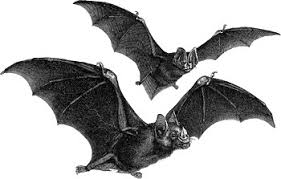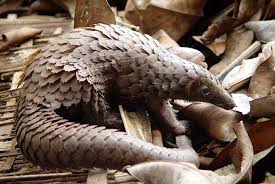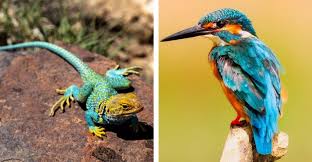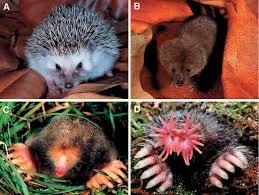This article discusses the order Insectivora (insect-eating mammals), the bats, order Chiroptera (the only mammals possessing the ability to fly), the pangolins, order Pholidota (mammals with overlapping reptilian-like scales), and the hares and rabbits that belong to the order Lagomorpha. A few common reptiles and birds are also discussed.
Order Insectivora: Primitive Insect-eating Mammals
The insectivores are primitive insect-eating mammals that occur in most parts of the world other than Australia and South America. These animals are small (weighing less than 1kg), have short limbs, four or five unspecialised digits on each foot, an elongated nasal region, and characteristic teeth adapted for holding and crushing invertebrate prey. The following families are represented in Nigeria:
1. Soricidae (Shrews) have soft, dense pelage and are the most common insectivores in Nigeria.
2. Tenrecidae (Otter-shrews) also have soft, dense pelage.
3. Erinaceidae (Hedgehogs) have thickened hairs which form spines on the dorsal surface of the body.
Shrews are mostly solitary animals. It is rare to see more than two individuals together outside the breeding season.
Read Also: The Techniques Used for Enhancing Farm Yield
Order Chiroptera: Hand-winged Mammals (Bats)

Chiroptera, meaning ‘hand-winged’, are the only mammals capable of flight. Their wings consist of a fold of skin stretched from the fingers along the arms and sides of the body to the hind legs.
The wing is supported by elongated digits of the forelimbs, while the hind limbs are short with well-developed claws used to suspend the body head-downwards when at rest. Bats are almost exclusively nocturnal, flying at night in search of food.
Bats are classified into two main suborders:
i. Micro-chiroptera (Insectivorous bats)
ii. Mega-chiroptera (Fruit-eating bats)
In Nigeria, fruit bats can cause serious damage to commercial fruit crops, while insectivorous bats tend to be smaller.
Order Pholidota: Scaly Anteaters (Pangolins)

Pangolins are mammals with overlapping reptilian-like scales made of cemented hairs covering their body, except for the soft underside. Found throughout West Africa, they curl into a tight ball when disturbed, using their strong abdominal muscles to protect themselves from predators.
They possess long, slender snouts, and a long, sticky tongue used to feed on ants and termites. Their legs are short with clawed toes, especially the forelimbs, which are adapted to break open ant nests or rip bark from trees. Ground pangolins are larger with massive scales, while tree pangolins are smaller with delicate scales and prehensile tails.
Order Lagomorpha: Hares and Rabbits
In Nigeria, the order Lagomorpha is represented by two species of hares, Lepus capensis and Lepus crawshayi. These animals have long silky ears, soft dense pelage, short fluffy tails, and powerful hindlimbs. Their teeth differ from rodents, with four upper incisors and six cheek teeth on each side of the skull.
Hares live in grassland savannas and derived savanna habitats in the rainforest zone. They are primarily herbivores.
Read Also: 16 Medicinal Health Benefits Of Pomaderris kumeraho (Kumerahou)
Reptiles and Birds of Nigeria

Nigeria is home to diverse species of reptiles and birds. Reptiles, covered in scales and generally cold-blooded, lay eggs and offer no parental care. While many reptiles are feared, such as snakes, not all are dangerous, and legless lizards are often mistaken for snakes. Nigerian parks boast a rich birdlife that is easily spotted.
1. Nile Monitor Lizard (Varanus niloticus)
The largest African lizard, with a stout body, powerful limbs, and a long tail. It is primarily aquatic, basking in the sun before hunting for food, which includes crabs, frogs, fish, and other small animals. It is also known to feed on crocodile eggs.
2. Nile Crocodile (Crocodilus niloticus)
Crocodiles, Africa’s largest reptiles, can grow up to 6 meters and weigh up to 990kg. These powerful predators are adept hunters, using their massive jaws and sharp teeth to rip apart prey. Crocodiles are unable to chew their food and instead swallow large chunks whole. They bask in the sun to regulate their body temperature and can produce 25-100 young after a 95-100 day gestation period.
3. Bush Fowl (Francolinus bicalcaratus)
Commonly found in West Africa, the bush fowl has brownish plumage with distinctive feather patterning. These ground-living birds move in small parties in search of food and are known for their whirring flight when disturbed.
4. Ostrich (Struthio camelus)
The ostrich is the largest living bird, endemic to Africa. Males can reach up to 3 meters in height and weigh more than 150kg. Ostriches are flightless but can run at speeds of up to 70km/h, using their powerful legs to escape predators. They live in large flocks and are known for their large eggs, which are the largest of any living bird.
Do you have any questions, suggestions, or contributions? If so, please feel free to use the comment box below to share your thoughts. We also encourage you to kindly share this information with others who might benefit from it. Since we can’t reach everyone at once, we truly appreciate your help in spreading the word. Thank you so much for your support and for sharing!
Read Also: Best Organic Fertilizer for Vegetables

